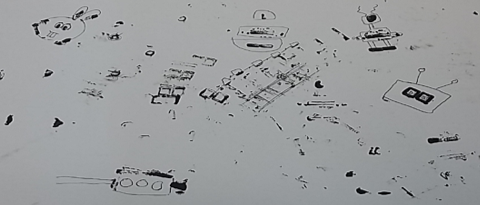This session further clarified the need for children to “engage with both ‘creating’ and ‘consuming’ the arts” (Callaway and Kear, 2000b, p.28). Using organic forms to create marks through inked handprints provided the “stimulus and first-hand experience” (Callaway and Kear, 2000b, p.28) that children require to experience through the arts. However, this task proved challenging as I lacked in creativity skills and imagination.
Moreover, this proved a useful activity to replicate as a future arts educator as it encompasses “personalisation and choice, thought-provoking starting points, and open-ended enquiry” (Education Scotland, 2013, p.14) which help develop creativity skills in young people.
Furthermore, seeing other people’s creations provided a useful, different perspective which may be provide inspiration. Additionally, I have always had an interest for art as I remember volunteering to help with decorations for school shows or wall displays. As an art educator, I hope to inspire the same enjoyment that art can bring and help children to realise it is more than just observing or copying from a famous artist but rather focus and develop the child’s artistic skill through the creative process.
With regards to the dance session, my prior dance experiences have been limited to participating in Zumba in physical education in high school.
I have presented a summary to my initial feelings prior to the session below:
During this session, I participated in some activities that were outside of my comfort zone such as a variety of “Follow the leader” games whereby dance moves were copied. We also did a useful introductory game which included producing a pose to present. On one hand, I did not enjoy these activities as I am quite an introverted person and this brought me out of my comfort zone. On the other hand, I understand that more confident children would thoroughly enjoy these activities and it would provide a good stepping stone for less confident children as example moves could also be provided as stimulus by the teacher or encouragement could be given from classmates. Cone (2011) made me question the activities in this session a lot as she raises concerns of too much teacher intervention in suggesting movements. However, this activity was mostly student led which I think is more effective and more fun for the students which I intend to replicate.
Furthermore, “Integrative education is defined as education that promotes learning and teaching in non-fragmented ways that embrace notions of holism, complexity, and interconnection” (Gnanakan, 2011, p.14 in Marshall, 2014, p.3). This dance session was integrated with science through linking warm up activities to learning the names of body parts which provided a useful insight into the possibilities that interdisciplinary learning provides.
I also understand that many children may have a similar response to dance than I have and that some children may be even shyer and require more encouragement than I do. Therefore, I aim to make the most of these sessions and continue participating in activities that I am not entirely comfortable with in order to put myself in a potential shy child’s perspective. To counteract this, children could work in mixed groups so that more able and more confident children are put together with shy children as peers can provide moral support for each other. To further incorporate a cross-curricular approach to dance, Cone (2011) suggests expressing identity through dance which in the session, we assimilated the Scottish identity by recreating points of cultural significance such as the Scotland flag and Loch Ness. I think this is a great way to get all children to be able to relate more to dance and realise it is not all about learning steps or routines.
My whole perspective and anxieties on being a dance educator were turned around by the end of this session as through the activities I participated in, I realised as long as I had a firm grasp on the 10 basic steps that every dance educator should know, my exaggerated fears and anxieties were unnecessary.
References
Education Scotland (2013) Creativity Across Learning 3 – 18 [Online] Available: http://www.educationscotland.gov.uk/Images/Creativity3to18_tcm4-814361.pdf [Accessed: 7 December 2016].
Marshall, J (2014) Transforming Education Through Art Centered Integrated Learning [Online] Available: https://static1.squarespace.com/static/54cfc63de4b08a9c05c7b299/t/55ad8587e4b099ab1ca12d0e/1437435271198/Integrated_Learning_and_Transforming_Education.pdf [Accessed: 12 December 2016].
Callaway, G and Kear, M (eds) (2000b) Improving Teaching and Learning in the Arts [Print] London: Falmer Press
Cone, T (2009) Following Their Lead: Supporting Children’s Ideas for creating dances, Journal of Dance Education [Abstract, Online] Available: http:/dx.doi.org/10/1080/15290824.2009.10387390 [Accessed: 6 October 2016].


